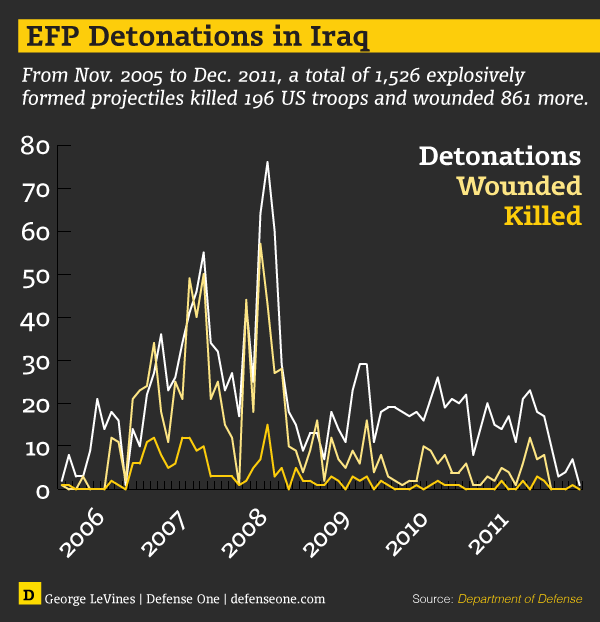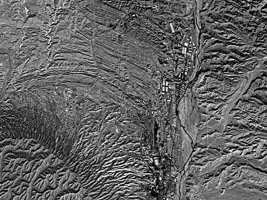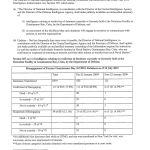How Many US Troops Were Killed By Iranian IEDs in Iraq?
DefenseOne: Explosively formed penetrators — a particularly deadly form of roadside bomb — killed 196 American soldiers in Iraq over a five-and-a-half-year period, according to recently declassified Pentagon documents.
That’s about half as many deaths as lawmakers have attributed to the bombs, which U.S. officials say were largely supplied by Iran’s elite Quds Force.
The carnage wrought by EFPs returned to the news over the summer, as opponents of the nuclear deal with Iran cited Tehran’s behind-the-scenes actions against U.S. troops during Operation Iraqi Freedom as a reason to scuttle the agreement. Sen. Ted Cruz, a Texas Republican who is also running for president, and others in Congress have said that EFPs had killed more than 500 troops.
“I understand that the Joint Personnel Recovery Agency has a classified list of roughly 500 American soldiers who were murdered by Iranian IEDs,” Cruz said at a July 29 Senate Armed Services Committee hearing.
But data from U.S. Central Command, which runs U.S. military operations in the Middle East, suggests the actual toll is far less. According to the first comprehensive accounting, between November 2005 and December 2011, 1,526 EFPs killed a total of 196 U.S. troops and injured 861.

Between October 2006 and September 2007, EFPs killed 97 U.S. troops and wounded more than 300 soldiers. EFP attacks peaked in March, April and May 2008, near the end of the American troop surge, when 200 of the bombs were detonated. The deadliest month was April 2008, when EFPs killed 15 U.S. soldiers.
The Pentagon attributes the presence of EFPs in Iraq to the Quds Force, the special forces arm of the Iranian Revolutionary Guard led by Qasem Suleimani. Various EFP “factories” were found throughout Iraq during Operation Iraqi Freedom. Still, the exact degree to which Iran bears culpability for arming Shia militias in Iraq with EFPs and related equipment is a matter of some dispute.
“We weren’t always able to attribute the casualties that we had to Iranian activity, although many times we suspected it was Iranian activity, even though we didn’t necessarily have the forensics to support that,” Gen. Joseph Dunford, the incoming chairman of the Joint Chiefs of Staff, said at his July 9 confirmation hearing. During the hearing, Dunford said the numbers of American soldiers killed by Iran “has been recently quoted as about 500.”
A few weeks later at the July 29 hearing, Gen. Martin Dempsey, the outgoing Joint Chiefs chairman, said “several hundred” American forces were killed by EFPs.
The arrival of EFPs on the Iraqi battlefield around 2005 came as a shock to U.S. planners. Along with more run-of-the-mill improvised explosive devices, the deadly bombs drove a crash effort to create and deploy vehicles with far better armor.
Whereas most roadside bombs send energy and shrapnel in all directions, EFPs work more like cannons. The force of the blast molds a concave metal disc, called a liner, into a “formed penetrator” which is propelled at up to 3,000 meters per second. The effect is incredibly destructive, even to up-armored Humvees.
“You can do as much or more damage with a 5-pound EFP, which is aimed, as with a 200-pound conventional IED,” a Pentagon analyst told Los Angeles Times writer Andrew Cockburn in 2007. The analyst speculated that the cost to construct such a device was about $30 or less. They’ve been around since at least World War II, when resistance elements in Europe used them against Germans, Cockburn wrote.
***Worse, in 2011, the Obama administration made an accusation and continued to deal in back channels for a nuclear deal.***
Obama Administration Accuses Iran of ‘Secret Deal’ With Al Qaeda
FNC: WASHINGTON — The Obama administration accused Iran on Thursday of entering into a “secret deal” with an Al Qaeda offshoot that provides money and recruits for attacks in Afghanistan and Pakistan. The Treasury Department designated six members of the unit as terrorists subject to U.S. sanctions.
The U.S. intelligence community has in the past disagreed about the extent of direct links between the Iranian government and Al Qaeda. Thursday’s allegations went further than what most analysts had previously said was a murky relationship with limited cooperation.
David S. Cohen, Treasury’s point man for terrorism and financial intelligence, said Iran entered a “secret deal with Al Qaeda allowing it to funnel funds and operatives through its territory.” He didn’t provide any details of that agreement, but said the sanctions seek to disrupt Al Qaeda’s work in Iraq and deny the terrorist group’s leadership much-needed support.
“Iran is the leading state sponsor of terrorism in the world today,” Cohen said in a statement. “We are illuminating yet another aspect of Iran’s unmatched support for terrorism.”
Treasury said the exposure of the clandestine agreement would disrupt Al Qaeda operations by shedding light on Iran’s role as a “critical transit point” for money and extremists reaching Pakistan and Afghanistan.
“This network serves as the core pipeline through which Al Qaeda moves money, facilitators and operatives from across the Middle East to South Asia,” it said..
Treasury said a branch headed by Ezedin Abdel Aziz Khalil was operating in Iran with the Tehran government’s blessing, funneling funds collected from across the Arab world to Al Qaeda’s senior leaders in Pakistan. Khalil, the department said, has operated within Iran’s borders for six years.
Also targeted by the sanctions is Atiyah Abd al-Rahman, appointed by Osama bin Laden as Al Qaeda’s envoy in Iran after serving as a commander in Pakistan’s tribal areas. As an emissary, al-Rahman is allowed to travel in and out of Iran with the permission of government officials, the statement claimed.
The sanctions block any assets the individuals might have held in the United States, and bans Americans from doing any business with them.
No Iranian officials were cited for complicity in terrorism. The others targeted were Umid Muhammadi, described as a key planner for Al Qaeda in Iraq’s attacks; Salim Hasan Khalifa Rashid al-Kuwari and Abdallah Ghanim Mafuz Muslim al-Khawar, Qatar-based financial supporters who’ve allegedly helped extremists travel across the region; and Ali Hassan Ali al-Ajmi, a Kuwait-based fundraiser for Al Qaeda and the Taliban.
The action comes a day after the top U.S. commander for special operations forces said Al Qaeda is bloodied and “nearing its end,” even as he warned that the next generation of militants could keep special operations fighting for a decade to come.
Navy SEAL Adm. Eric T. Olson said bin Laden’s killing on May 2 was a near-fatal blow for the organization created by bin Laden and led from his Pakistan hide out. He said the group already had lost steam because of the revolts of the Arab Spring, which proved the Muslim world did not need terrorism to bring down governments, from Tunisia to Egypt.
Treasury’s public allegations against Iran may reflect part of a strategy to expand the pressure on smaller, less well-established offshoots of Al Qaeda as the weakening of the group’s leadership threatens to make its activities more disparate. Washington already has re-focused much attention on Al Qaeda’s Yemen-based branch, which has attempted to bomb a U.S.-bound jetliner and cargo planes in recent years.
But the exact nature of Iran’s relationship with Al Qaeda remains disputed in Washington, with different branches of the intelligence community disagreeing about whether Iran is supporting Al Qaeda as a matter of policy, according to one U.S. official. The official spoke on condition of anonymity to discuss intelligence matters.
Some hardline militants backing Al Qaeda, members of Islam’s majority Sunnis, see the Shiite Islam dominant in Iran as heretical, and they view Tehran’s regional ambitions as a greater threat than the West. Sunni insurgents in Iraq have used car bombs and suicide attacks against Shiite targets, killing thousands since 2003, as well as targeting Shiite militias allied to Iran.
Since 2001, Iran has appeared a somewhat reluctant host for senior Al Qaeda operatives who fled there after the U.S. invasion of Afghanistan, keeping them under tight restrictions. After an initial period of cooperation with the West, Iran now seems to be a more comfortable haven even if it remains on the edge of Al Qaeda’s orbit.
Western officials point to the release earlier this year of an Iranian diplomat who was held for 15 months after being kidnapped by gunmen in Pakistan.
In negotiations for the diplomat’s freedom, they say Iran promised better conditions for dozens of people close to Osama bin Laden who were being held under tight security. These included some of the terror chief’s children and the network’s most senior military strategist, Saif al-Adel.
Still, the life of the Al Qaeda-linked exiles in Iran continues to be very much a blind spot for Western intelligence agencies. Few firm details have emerged, such as how much Iran limits their movements and contacts.



